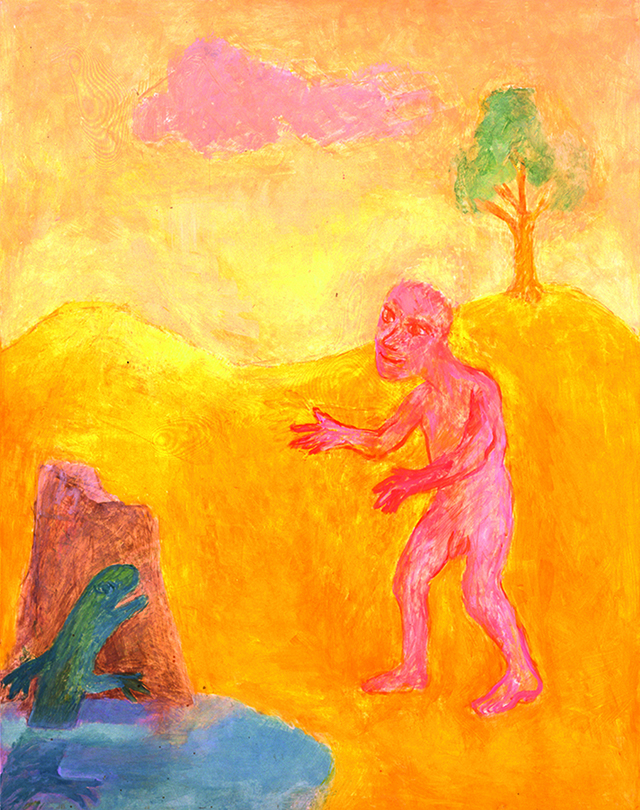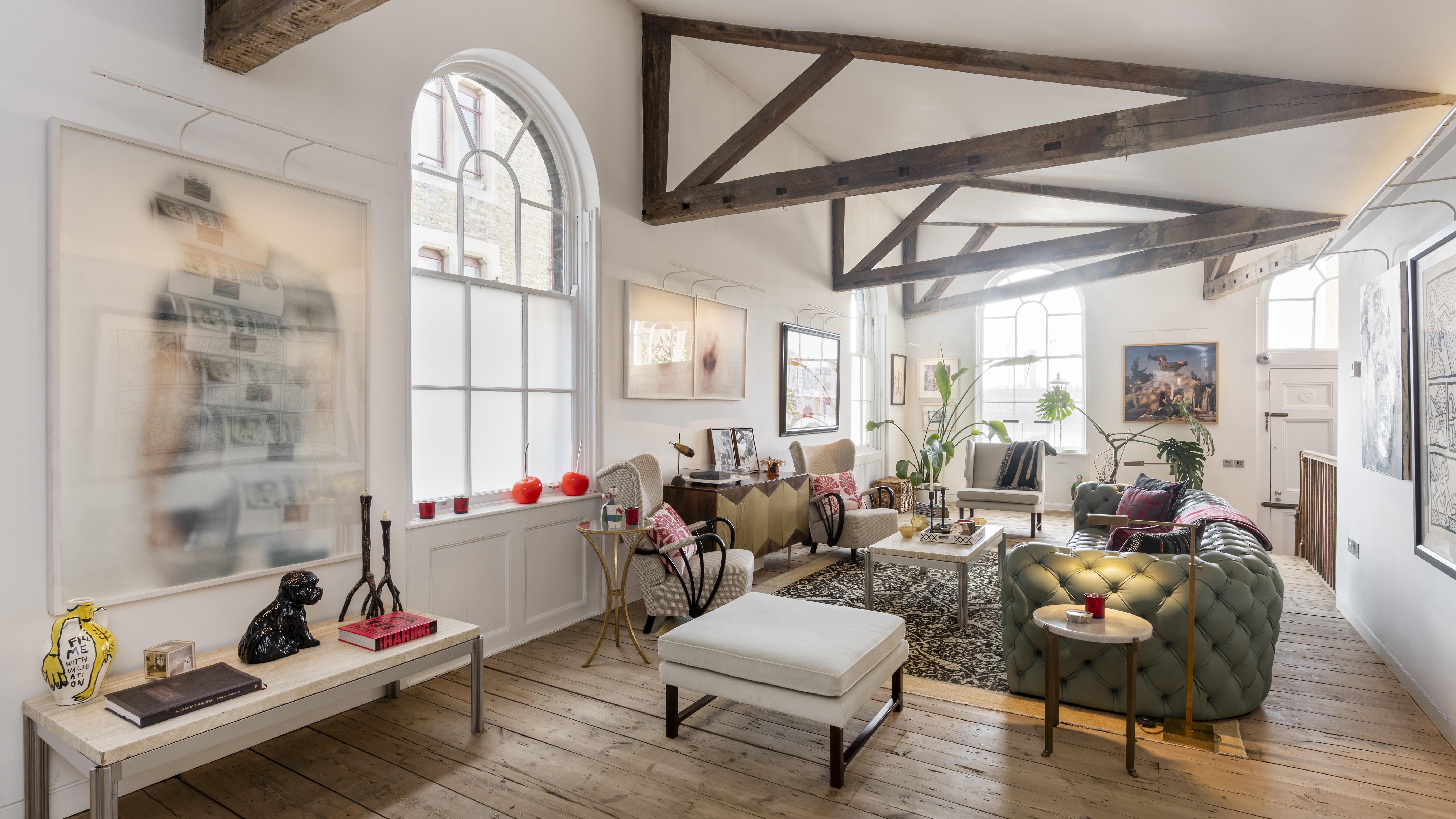My favourite painting: Emily Young
Emily Young chooses a picture by a teacher from her time at Chelsea School of Art as her favourite painting


Man and Salamander, 1970–5, by Ken Kiff RA (1935–2001), 353⁄4in by 28in, Collection: Emily Young
Emily says: ‘I came across Ken Kiff’s paintings when I was an art student at Chelsea and he was a tacher there. It was a tough time to be a figurative painter, which we both were, and Ken was the only person who liked my work. I loved his, and still do: the brilliant colours, the cadmium yellows and the way his pictures told stories of that basic thing, which I still work with—the figure in a landscape, human consciousness in the physical world, which, in his case, was told with intense joy, delicacy and power. This painting has hung on my wall for years now and it still fills me with wonder.’
Emily Young is a stone-carver and writer. Some of her recent sculptures are on show at the Chiesa della Madonna dell’Orto in Venice until November 22
John McEwen comments on Man and Salamander: ‘Forms take reality for me as I work. In other words, rather than setting out to paint something, I begin painting and, as I paint, the picture begins to assert itself, or suggest itself under my brush,’ wrote Ken Kiff in 1985, echoing Paul Klee.
He was born in Dagenham in 1935. His father, at one time a woodyard worker, was killed in the Blitz and the family had to live with relatives. Kiff began to suffer from nocturnal nervous attacks, wrongly diagnosed as epilepsy. Regular visits to Great Ormond Street Hospital for sedative treatment followed. But he did well at school, passing the 11-plus exam to enter grammar school. When, as an art-school teacher many years later, he spoke of his childhood woes, a colleague made him laugh, saying: ‘We haven’t all had your advantages.’
Leaving school at 16, he worked for two years in a public library—it proved his further education. He found poetry a particular solace and became engrossed by art, drawing cartoons for the staff magazine. Evening classes in still-life and portrait painting led to art school. His confidence and self-awareness were fostered by psychotherapy and, in due course, he married an artist who became a psychotherapist.
Among his interests at art school was stained glass, which enriched his palette. Chagall, Klee, miró and Dubuffet were among his influences. Kiff was always reluctant to say a painting was finished and what it was about, but he often describes a journey, humorous and perilous, with himself as protagonist.
Sign up for the Country Life Newsletter
Exquisite houses, the beauty of Nature, and how to get the most from your life, straight to your inbox.
** Read the rest of our favourite paintings series
Country Life is unlike any other magazine: the only glossy weekly on the newsstand and the only magazine that has been guest-edited by HRH The King not once, but twice. It is a celebration of modern rural life and all its diverse joys and pleasures — that was first published in Queen Victoria's Diamond Jubilee year. Our eclectic mixture of witty and informative content — from the most up-to-date property news and commentary and a coveted glimpse inside some of the UK's best houses and gardens, to gardening, the arts and interior design, written by experts in their field — still cannot be found in print or online, anywhere else.
-
 Graham Norton's elegant East London home hits the market, and it's just as wonderful as you would expect
Graham Norton's elegant East London home hits the market, and it's just as wonderful as you would expectThe four-bedroom home in Wapping should be studied for how well it uses two separate spaces to create a home of immense character and utility.
-
 Sign of the times: In the age of the selfie, what’s happening to the humble autograph?
Sign of the times: In the age of the selfie, what’s happening to the humble autograph?When Ringo Starr announced that he was no longer going to sign anything, he kickstarted a celebrity movement that coincided with the advent of the camera phone and selfie. Rob Crossan asks whether, in today’s world, the selfie holds more clout than an autograph?
-
 'As a child I wanted to snuggle up with the dogs and be part of it': Alexia Robinson chooses her favourite painting
'As a child I wanted to snuggle up with the dogs and be part of it': Alexia Robinson chooses her favourite paintingAlexia Robinson, founder of Love British Food, chooses an Edwin Landseer classic.
-
 The Pre-Raphaelite painter who swapped 'willowy, nubile women' for stained glass — and created some of the best examples in Britain
The Pre-Raphaelite painter who swapped 'willowy, nubile women' for stained glass — and created some of the best examples in BritainThe painter Edward Burne-Jones turned from paint to glass for much of his career. James Hughes, director of the Victorian Society, chooses a glass masterpiece by Burne-Jones as his favourite 'painting'.
-
 'I can’t look away. I’m captivated': The painter who takes years over each portrait, with the only guarantee being that it won't look like the subject
'I can’t look away. I’m captivated': The painter who takes years over each portrait, with the only guarantee being that it won't look like the subjectFor Country Life's My Favourite Painting slot, the writer Emily Howes chooses a work by a daring and challenging artist: Frank Auerbach.
-
 My Favourite Painting: Rob Houchen
My Favourite Painting: Rob HouchenThe actor Rob Houchen chooses a bold and challenging Egon Schiele work.
-
 My Favourite Painting: Jeremy Clarkson
My Favourite Painting: Jeremy Clarkson'That's why this is my favourite painting. Because it invites you to imagine'
-
 The chair of the National Gallery names his favourite from among the 2,300 masterpieces — and it will come as a bit of a shock
The chair of the National Gallery names his favourite from among the 2,300 masterpieces — and it will come as a bit of a shockAs the National Gallery turns 200, the chair of its board of trustees, John Booth, chooses his favourite painting.
-
 'A wonderful reminder of what the countryside could and should be': The 200-year-old watercolour of a world fast disappearing
'A wonderful reminder of what the countryside could and should be': The 200-year-old watercolour of a world fast disappearingChristopher Price of the Rare Breed Survival Trust on the bucolic beauty of The Magic Apple Tree by Samuel Palmer, which he nominates as his favourite painting.
-
 My favourite painting: Andrew Graham-Dixon
My favourite painting: Andrew Graham-Dixon'Lesson Number One: it’s the pictures that baffle and tantalise you that stay in the mind forever .'